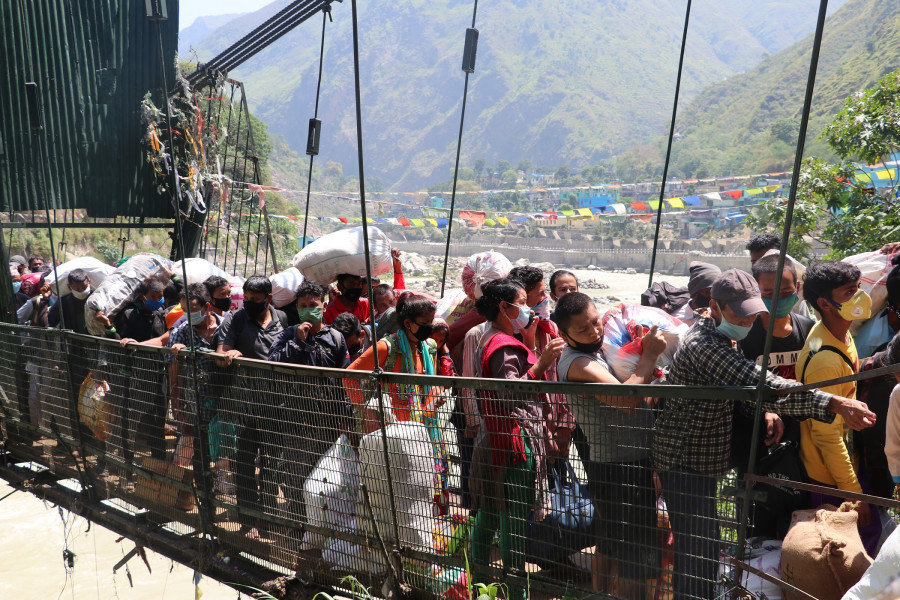Sudurpaschim Province
Lax approach by authorities in dealing with new arrivals could spell a disaster for Sudurpaschim
Lack of coordination among government agencies and poor policy to blame for the spike in coronavirus cases, health officials say.
Chitranga Thapa
In the last few weeks, various districts in Sudurpaschim Province have reported a rise in coronavirus cases, mostly among those entering the province from India, say health officials.
Province Health Director Dr Gunaraj Awasthi said that since the lifting of the lockdown on July 21, the authorities have loosened the security checks that were being conducted at various border points. This has led to people, who entered Nepal from India, to reach their home districts without any health check-ups.
“There is no record of how many people entered Nepal through various border points and reached their respective villages,” said Awasthi, “But we ran tests on samples collected in districts where there has been an influx of returnees post lockdown. Some samples tested positive which hints at the new arrivals being carriers of the virus.”
With the lifting of the nationwide lockdown in July, movement of people across the border, including through Gauriphanta and Gaddachauki border points, has been steady despite a ban on cross-border movement.
Siddharaj Bhatta, focal person for Covid-19 at Kanchanpur Health Office, said that people coming from outside of the province, including India, do not stay in quarantine facilities which has contributed to the increase of new Covid-19 cases.
“People coming from outside are refusing to stay in quarantine, which has increased the number of cases in the province,” said Bhatta. “At present around 300 people enter from Gauriphanta border point while around 75 enter Nepal from the Gaddachauki border point on a daily basis.”
Armed Police Force DSP Keshav Pyakurel of the Gaddachauki border point in Kanchanpur said that they have been taking records of the people coming from India and are putting them in contact with their respective local representatives.
“We have been coordinating with the local authorities while sending people who come from across the border,” said Pyakurel. “The local units have formed a committee under each ward chairman. We inform them regarding the people from their area following which they are sent to their respective quarantine facilities.”
There were only five infected individuals in the province during the months of March and April. New infections weren’t detected until the third week of May. Since then, the province has recorded 4,691 Covid-19 cases, according to the data at the Regional Health Directorate.
Public health experts and local representatives blame the lack of coordination among government agencies and poor policy behind the spike in the coronavirus cases in Sudurpaschim Province.
Narendra Singh Karki, chief at the Health Division in the province, said that open border between Indian and Nepal is one of the major challenges they are facing in controlling the spread of the coronavirus.
“All levels of government must coordinate to properly conduct health check-ups of the people who are coming back from India and place them in quarantine centres,” said Karki, adding that the provincial government is expanding the testing field, establishing isolation facilities and conducting contact tracing.
The government had earlier directed that every individual entering the province from outside be kept in quarantine facilities for 14 days. The directive was later revised and the local authorities were asked to send asymptomatic Covid-19 infected individuals home to self-quarantine. For those coming from outside the country, the health ministry has mandated compulsory stay in holding centres at the border points for five days before undergoing polymerase chain reaction tests. Only after tests, they are sent to the quarantine centres in their respective hometowns and villages.
However, Kanchanpur Bedkot Municipality Mayor Ashok Chand says that the returnees are not adhering to the rules and they have not been contacting the authorities concerned upon their return to the villages.
“The risk of community transmission has increased as people are entering their villages without observing mandatory quarantine period and health screening,” said Chand. “It’s difficult for us to keep track of the people entering the local units since they don’t inform the authorities about their return. We don’t know when and from which entry points people are using to cross into Nepal from India. If this continues, we will revert to earlier months when we were overwhelmed by the number of infections.”
Chand also pointed out the lack of coordination among government agencies which has led to confusion among local units.
“The ministries themselves aren’t in agreement with one another policy-wise,” said Chand. “On one hand, the Health Ministry asked us to make arrangements for quarantine and isolation facilities in school buildings and government offices. On the other hand, the Education Ministry has asked us to clear out the school buildings so that classes could be resumed.”
Earlier, around 2,500 quarantine centres and 312 isolation beds were set up at 88 local units of nine districts in the province. But, since most people suspected with Covid-19 have been asked to observe quarantine at their homes, the number of facilities have come down to 1,342. At present 424 women and 1,054 men are staying in these quarantine facilities.




 24.94°C Kathmandu
24.94°C Kathmandu














